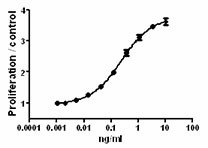- Regulatory Status
- RUO
- Other Names
- Interleukin-3, Burst promoting activity, Eosinophil colony stimulating factor (Eo-CSF), Hematopoietic cell growth factor (HCGF), Mast (MGF/MCGF), Multi-colony stimulating (Multi-CSF), P cell stimulating activity (PCSA), Thy1 inducing factor

-

TF-1 cell proliferation induced by human IL-3.
| Cat # | Size | Price | Quantity Check Availability | ||
|---|---|---|---|---|---|
| 578002 | 10 µg | $176.00 | |||
| 578004 | 25 µg | $347.00 | |||
| 578006 | 100 µg | $581.00 | |||
| 578008 | 500 µg | $1378.00 | |||
Interleukin-3 is a hemopoietic growth factor involved in the survival, proliferation, and differentiation of multipotent hemopoietic cells. IL-3 is the most potent growth factor for basophils, followed by granulocyte-macrophage colony-stimulating factor and IL-5. These cytokines also act on mature basophils through specific receptors, thereby mediating adhesion, migration, and releasability. IL-3 is highly expressed by mast cells, and large and rapidly released amounts of autocrine IL-3 production are responsible for mast cell survival by IgE in the absence of antigen. IL-3 has also been implicated in the pathogenesis of several chronic inflammatory diseases, including asthma, atherosclerosis, and neurodegenerative disorders, such as multiple sclerosis. IL-3 stimulates colony formation of megakaryocytes, neutrophils, and macrophages from bone marrow cultures. IL-3 plays a vital role in stimulating basophils and mast cell responses to parasite infections, and since basophils play an important role in Th2 immune responses, IL-3 is a critical regulator of allergic inflammation. IL-3 is expressed in the major embryonic vessels and regulates the survival and proliferation of hematopoietic stem cells in the early stages of embryonic development.
Product Details
- Source
- Human IL-3, amino acids Ala20-Phe152 (Accession# P08700), was expressed in Insect cells. The C-terminus contains a linker-8His-tag.
- Molecular Mass
- The 150 amino acid recombinant protein has a predicted molecular mass of 17 kD. The DTT-reduced protein migrates in the range of 18 to 25 kD by SDS-PAGE.
- Purity
- >98%, as determined by Coomassie stained SDS-PAGE.
- Formulation
- 0.22 µm filtered protein solution is in 20 mM NaH2PO4, 0.30 M NaCl, pH 6.0.
- Endotoxin Level
- Less than 0.01 ng per µg cytokine as determined by the LAL method.
- Concentration
- 10 and 25 µg sizes are bottled at 200 µg/mL. 100 µg size and larger sizes are lot-specific and bottled at the concentration indicated on the vial. To obtain lot-specific concentration and expiration, please enter the lot number in our Certificate of Analysis online tool.
- Storage & Handling
- Unopened vial can be stored between 2°C and 8°C for up to 2 weeks, at -20°C for up to six months, or at -70°C or colder until the expiration date. For maximum results, quick spin vial prior to opening. The protein can be aliquoted and stored at -20°C or colder. Stock solutions can also be prepared at 50 - 100 µg/mL in appropriate sterile buffer, carrier protein such as 0.2 - 1% BSA or HSA can be added when preparing the stock solution. Aliquots can be stored between 2°C and 8°C for up to one week and stored at -20°C or colder for up to 3 months. Avoid repeated freeze/thaw cycles.
- Activity
-
Human IL-3 stimulates the proliferation of TF-1 human erythroleukemic cells in a dose-dependent manner. The ED50 = 0.05 – 0.3 ng/mL.
The specific activity of recombinant human IL-3 is approximately 1.64 x 103 IU/µg when compared against the 1st WHO International Standard for Human IL-3 (NIBSC code: 91/510).
For more information on specific activity, please visit the Recombinant Protein Unit Conversions page. - Application
-
Bioassay
- Application Notes
-
BioLegend carrier-free recombinant proteins provided in liquid format are shipped on blue-ice. Our comparison testing data indicates that when handled and stored as recommended, the liquid format has equal or better stability and shelf-life compared to commercially available lyophilized proteins after reconstitution. Our liquid proteins are verified in-house to maintain activity after shipping on blue ice and are backed by our 100% satisfaction guarantee. If you have any concerns, contact us at tech@biolegend.com.
- Product Citations
-
Antigen Details
- Structure
- Heterodimer
- Distribution
-
Activated T cells, Th1, Th2, mast cells, eosinophils, keratinocytes, NK cells, and endothelial cells.
- Function
- IL-3 is a pleiotropic factor which promotes both self-renewal and differentiation of early multipotential progenitors and is involved in inducible hematopoiesis in response to infections.
- Interaction
- Erythroid cells, megakaryocytes, neutrophils, eosinophils, basophils, mast cells, monocytic lineages.
- Ligand/Receptor
- Heterodimer IL-3Rα (CD123) and a common β subunit (βc) that is shared with the IL-5R and GM-CSFR.
- Cell Type
- Hematopoietic stem and progenitors
- Biology Area
- Cell Biology, Signal Transduction, Stem Cells
- Molecular Family
- Cytokines/Chemokines
- Antigen References
-
1. Kitamura T, et al. 1989. J. Cell. Physiol. 140:323.
2. Kohno M, et al. 2005. Blood 105:2059.
3. Murphy JM and Young IG, 2006. Vitam. Horm. 74:1.
4. Kleemann R, et al. 2008. Cardiovasc. Res. 79:360.
5. Valent P, and Dahinden CA. 2010. Curr. Opin. Hematol. 17:60.
6. Mirza S, et al. 2010. J. Biol. Chem. 285:22370. - Gene ID
- 3562 View all products for this Gene ID
- UniProt
- View information about IL-3 on UniProt.org
